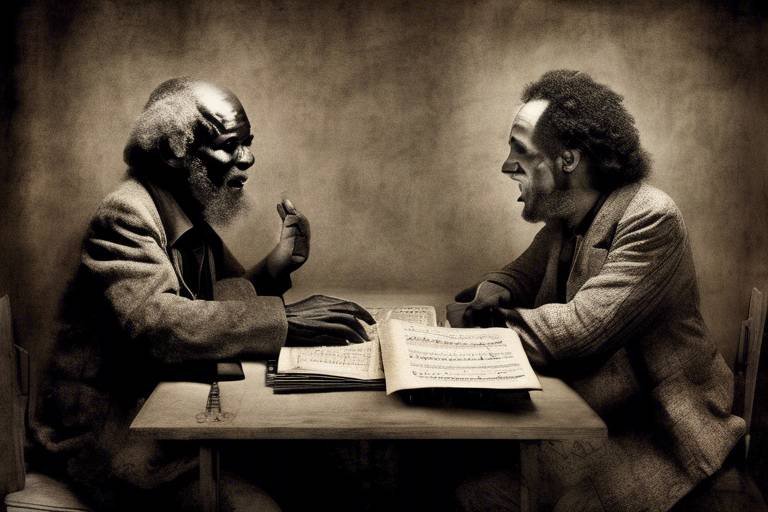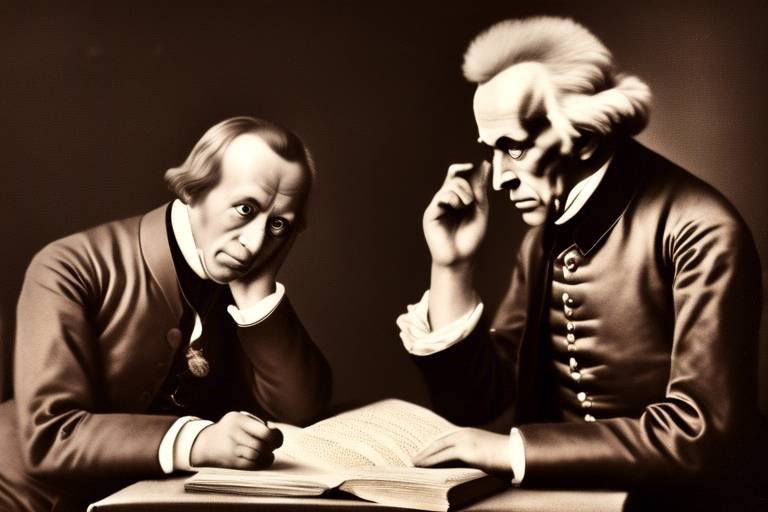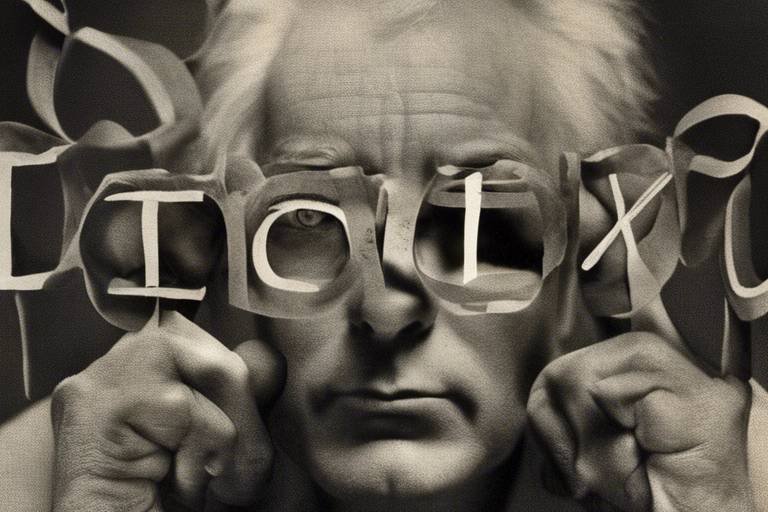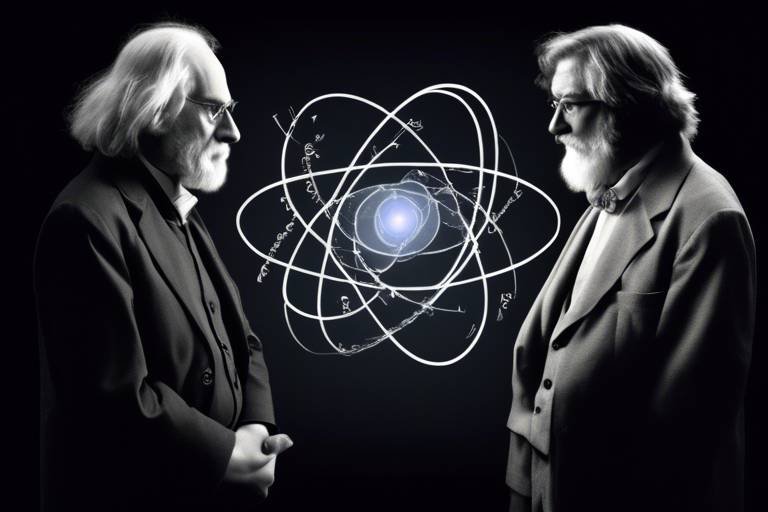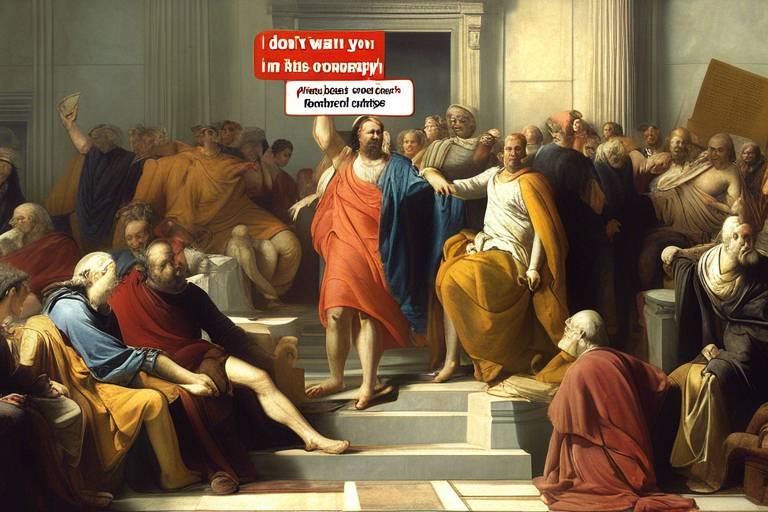Is Philosophy a Science or an Art?
Philosophy has long been a subject of debate, often caught in the crossfire between the realms of science and art. At first glance, one might think that these two domains are worlds apart, like oil and water. However, upon closer inspection, it becomes clear that philosophy intertwines with both, creating a rich tapestry of inquiry that captivates the mind. So, is philosophy a science? Is it an art? Or perhaps it is a bit of both? This article aims to unravel this intriguing question, examining the fundamental nature of philosophy and the arguments that support its classification.
To begin with, we must recognize that philosophy is not a monolithic discipline. It encompasses a wide range of inquiries, from ethics and politics to metaphysics and epistemology. Each branch of philosophy can exhibit characteristics that align more closely with either scientific methods or artistic expression. Think of philosophy as a vast landscape filled with various paths—some leading to the rigorous mountains of scientific reasoning, while others meander through the lush valleys of creative thought.
As we delve into this discussion, we will explore the methodologies that underpin the scientific perspective of philosophy, such as logical analysis and empirical foundations. These elements suggest that philosophy can indeed function as a science, employing systematic approaches that mirror those found in the natural sciences. However, we will also examine the artistic dimensions of philosophy, emphasizing the role of interpretation and creative expression. Just as a painter interprets the world through their brushstrokes, philosophers interpret the complexities of existence through their thoughts and writings.
Ultimately, this exploration will lead us to consider how contemporary philosophers are bridging the gap between science and art, proposing a more integrated approach to philosophical inquiry. By examining both sides of this debate, we can appreciate the multifaceted nature of philosophy, recognizing that it is not simply a question of classification. Rather, it is an invitation to engage in a deeper dialogue about the essence of human thought and understanding.
- Can philosophy be both a science and an art? Yes, many believe that philosophy incorporates elements of both disciplines, allowing for a rich exploration of ideas.
- What are some examples of philosophical inquiries that resemble scientific methods? Inquiries in ethics, logic, and epistemology often employ systematic approaches similar to scientific methods.
- How does interpretation play a role in philosophy? Interpretation is crucial in philosophy, as different perspectives can lead to diverse meanings and insights, much like in art.
- Why is it important to bridge science and art in philosophy? Bridging these two realms allows for a more holistic understanding of philosophical questions, enriching the inquiry process.

The Nature of Philosophy
Philosophy is a fascinating field that stretches across a vast landscape of human thought, inquiry, and reflection. At its core, it seeks to answer some of the most fundamental questions about existence, knowledge, values, reason, mind, and language. It's like a grand tapestry woven from the threads of countless ideas, each contributing to a larger narrative about what it means to be human. But what exactly defines philosophy? Is it merely a collection of abstract thoughts, or does it serve a deeper purpose in our lives?
To truly understand the nature of philosophy, we must first recognize its broad scope. It encompasses various branches, including:
- Ethics: The study of morality and what constitutes right or wrong behavior.
- Metaphysics: The exploration of the fundamental nature of reality, including concepts like being, existence, and the universe.
- Epistemology: The investigation of knowledge, belief, and the nature of justification.
- Logic: The examination of reasoning and argumentation.
- Aesthetics: The study of beauty, art, and taste.
These branches highlight that philosophy isn't just one thing; it's a multifaceted discipline that interacts with various aspects of life and knowledge. Think of it as a toolbox, where each tool represents a different philosophical approach or method, ready to be utilized in the pursuit of understanding. Whether you're grappling with ethical dilemmas or pondering the nature of reality, philosophy provides the instruments necessary to dissect and analyze complex issues.
Moreover, philosophy is not static; it evolves over time, influenced by cultural, historical, and scientific developments. Just as art reflects the society from which it emerges, philosophy mirrors the intellectual currents of its time. This dynamic nature makes philosophy an ever-relevant field, as it continuously adapts to new discoveries and societal changes. For instance, the advent of modern science has prompted philosophers to reassess traditional metaphysical questions, leading to new interpretations and frameworks.
Ultimately, the nature of philosophy invites us to engage in deep, critical thinking and encourages a spirit of inquiry. It urges us to question our assumptions and consider multiple perspectives. In a world where information is abundant but understanding is often superficial, philosophy stands as a beacon, guiding us toward a deeper comprehension of ourselves and the universe we inhabit. So, is philosophy a science, an art, or perhaps a blend of both? The answer may lie in the very act of philosophizing itself—a journey of discovery that transcends rigid classifications.

Philosophy as a Science
When we think about philosophy, the first images that often come to mind are those of deep thinkers pondering the mysteries of existence or grappling with ethical dilemmas. But what if I told you that philosophy also wears the hat of a scientist? Yes, proponents of the scientific view argue that philosophy employs systematic methods akin to those in the sciences. This perspective is not just a passing thought; it’s a robust framework that allows for rigorous inquiry and analysis.
At its core, philosophy seeks to understand fundamental truths about the world, much like science. It asks questions that probe the very fabric of reality, existence, and knowledge. This is where the methodologies come into play. Philosophers often utilize logical reasoning, which mirrors the scientific method. They construct arguments, analyze premises, and draw conclusions based on established principles. Just like scientists form hypotheses and test them, philosophers formulate theories and challenge them through logical analysis.
Now, let's dive deeper into one of the critical tools in philosophy: logical analysis. This technique is not merely an academic exercise; it’s a vital component that aligns philosophical inquiry with scientific reasoning. By employing logical frameworks, philosophers can dissect complex ideas, clarify concepts, and evaluate arguments with precision. Think of it as a mental toolkit that helps philosophers navigate the often murky waters of abstract thought.
For instance, consider a philosophical argument about free will. A philosopher might start with a premise that states, "If determinism is true, then free will does not exist." Through logical analysis, they can explore the implications of this statement, examining counterarguments and supporting evidence. This process is strikingly similar to how a scientist would approach a hypothesis, testing its validity against observations and experiments.
Moreover, some philosophical inquiries rely heavily on empirical evidence, much like scientific research. This is particularly evident in fields such as philosophy of mind or ethics, where empirical data can inform discussions about consciousness, morality, and human behavior. For example, philosophers might draw on psychological studies to understand how humans make moral decisions, blending philosophical inquiry with empirical findings.
This intersection of philosophy and empirical evidence not only strengthens the claim that philosophy can function as a science but also enriches the dialogue between the two disciplines. Philosophers who embrace empirical foundations often engage in interdisciplinary collaboration, working alongside scientists to explore questions that are both profound and practical. Here’s a quick look at how these empirical foundations manifest:
| Field of Inquiry | Philosophical Questions | Empirical Evidence |
|---|---|---|
| Philosophy of Mind | What is consciousness? | Neuroscientific studies on brain activity |
| Ethics | What influences moral decisions? | Psychological experiments on decision-making |
| Epistemology | How do we acquire knowledge? | Research in cognitive science |
In conclusion, while philosophy often dances in the realm of abstract thought, it is crucial to recognize its scientific dimensions. Logical analysis and empirical foundations provide a solid framework for philosophical inquiry, allowing it to align itself with the rigorous methodologies seen in the sciences. So, is philosophy a science? The answer might just be a resounding yes, as it continues to evolve and adapt, merging the lines between rigorous inquiry and creative exploration.

Logical Analysis
When we dive into the world of philosophy, one of the first things that stands out is the method of logical analysis. This technique is not just a fancy term thrown around by philosophers; it serves as a cornerstone of philosophical inquiry. Think of logical analysis as the lens through which we examine complex ideas, stripping them down to their core components, much like a mechanic disassembling an engine to understand how it works. By applying logical frameworks, philosophers can clarify arguments, identify fallacies, and establish a more solid foundation for their claims.
At its essence, logical analysis involves breaking down statements and arguments into their constituent parts. This process allows philosophers to evaluate the validity and soundness of their reasoning. For instance, when a philosopher makes a claim, they often follow it up with premises—these are the building blocks of their argument. Logical analysis helps in assessing whether these premises genuinely support the conclusion. If they don’t, it’s like trying to build a house on a shaky foundation; the entire structure is at risk of collapsing.
Moreover, logical analysis mirrors the scientific method in several ways. Both disciplines prioritize clarity, precision, and systematic approaches to inquiry. In science, hypotheses are tested through experimentation and observation, while in philosophy, logical analysis scrutinizes arguments to ensure they are coherent and logically consistent. This similarity is why many proponents argue that philosophy should be classified as a science. The use of symbols and formal logic can even resemble mathematical proofs, showcasing how structured reasoning plays a crucial role in both fields.
Consider the following table that illustrates the parallels between logical analysis in philosophy and the scientific method:
| Aspect | Philosophy (Logical Analysis) | Science (Scientific Method) |
|---|---|---|
| Objective | Clarify arguments and identify fallacies | Test hypotheses and draw conclusions |
| Methodology | Systematic breakdown of statements | Experimentation and observation |
| Outcome | Coherent and valid arguments | Empirical evidence and theories |
However, it’s essential to recognize that logical analysis isn’t just about cold, hard facts. It also requires a certain level of creativity and interpretation. Philosophers often need to think outside the box to formulate arguments that are not only logical but also engaging and thought-provoking. This blend of logic and creativity is what makes philosophical discourse so rich and dynamic.
In conclusion, logical analysis stands as a testament to the systematic nature of philosophy. It allows philosophers to dissect complex ideas, ensuring that their arguments are not only valid but also resonate with the human experience. By employing logical frameworks, philosophy can indeed align itself with scientific inquiry, showcasing its potential as a rigorous discipline that demands both critical thinking and creative expression.
- What is logical analysis in philosophy? Logical analysis is a method used to evaluate arguments by breaking them down into their fundamental components, ensuring clarity and validity.
- How does logical analysis relate to the scientific method? Both logical analysis and the scientific method prioritize systematic inquiry, clarity, and the evaluation of claims to ensure coherence and soundness.
- Can philosophy be considered a science? Many argue that due to its systematic methods and logical frameworks, philosophy can function similarly to science, particularly in its analytical approach.

Empirical Foundations
When we delve into the of philosophy, we uncover a fascinating intersection between philosophical inquiry and scientific investigation. At first glance, one might assume that philosophy is purely abstract, floating in a realm devoid of tangible evidence. However, many philosophical inquiries are deeply rooted in empirical evidence, much like scientific research. This relationship raises an intriguing question: can philosophy truly be considered a science if it relies on the same empirical methods that underpin scientific disciplines?
To explore this, we must first understand what we mean by empirical evidence. In essence, empirical evidence is information obtained through observation or experimentation. It’s the data that scientists collect to support their hypotheses, but philosophers also use similar forms of evidence to substantiate their arguments. For instance, when discussing ethical theories, philosophers may rely on psychological studies to understand human behavior and moral decision-making. This reliance on empirical data not only strengthens philosophical arguments but also aligns them with scientific methodologies.
Moreover, the relationship between philosophy and empirical evidence can be illustrated through various branches of philosophy, such as philosophy of science. Here, philosophers examine the foundations, assumptions, and implications of scientific practices. They often engage with empirical findings to critique or support scientific theories. For example, consider the debates surrounding the nature of consciousness. Philosophers like Daniel Dennett have drawn upon neurological studies to argue for a materialistic understanding of consciousness, effectively merging philosophical inquiry with empirical findings.
Additionally, the use of case studies in philosophical arguments further exemplifies how empirical foundations play a crucial role. Philosophers often analyze real-world scenarios to illustrate their points or to challenge existing theories. Take the trolley problem, a classic ethical dilemma; philosophers use this thought experiment to explore moral intuitions and decision-making processes. By examining how people react in these hypothetical situations, philosophers gather insights that are both philosophical and empirical in nature.
In summary, the of philosophy highlight its capacity to engage with the world in a way that is not only theoretical but also grounded in observable reality. This connection to empirical evidence allows philosophy to maintain relevance in an increasingly scientific world. It invites us to consider whether philosophy should be viewed solely as an artistic endeavor or if it can indeed hold its own as a science. Ultimately, this ongoing dialogue enriches both fields, fostering a deeper understanding of the complexities of human thought and experience.

Philosophy as an Art
When we think about philosophy, our minds often drift to rigorous debates and logical arguments. Yet, there's a compelling case to be made that philosophy is not just a science, but also a deeply artistic endeavor. At its core, philosophy is about exploring the human experience, and what better way to do that than through the lens of art? Just as a painter uses colors to express emotions, philosophers use concepts and ideas to delve into the complexities of existence. This artistic dimension of philosophy invites us to interpret, reflect, and create meaning in ways that resonate on a personal level.
One of the most striking aspects of philosophy as an art form is its reliance on interpretation. Just as a piece of art can evoke different feelings and thoughts in different viewers, philosophical texts can be interpreted in myriad ways. This subjectivity is not a flaw; instead, it enhances the richness of philosophical discourse. For example, consider the works of Socrates and Plato. Their dialogues can be viewed through various lenses—ethics, politics, or even aesthetics—each interpretation revealing new insights. This fluidity mirrors the experience of viewing a painting where the meaning shifts with each glance.
Moreover, the creative expression inherent in philosophy is akin to the process of crafting a piece of art. Philosophers often engage in a dance of ideas, much like a musician weaving melodies. This creative aspect allows them to explore abstract concepts and challenging questions in ways that are not only intellectually stimulating but also beautiful. When a philosopher writes, they are not just laying down arguments; they are crafting a narrative that invites readers to journey alongside them. This journey can be as profound as any artistic experience, prompting us to question our assumptions and expand our horizons.
To illustrate this artistic approach, let's consider some examples of how philosophy embodies artistic qualities:
- Metaphorical Language: Philosophers often use metaphors to explain complex ideas, much like poets do. This use of metaphor enriches the philosophical text and makes it more relatable.
- Personal Reflection: Many philosophical works are deeply personal, reflecting the author's own experiences and emotions, similar to autobiographical art.
- Innovative Structures: Philosophers sometimes break traditional structures in their writing, creating unique formats that challenge readers to engage differently, much like avant-garde art.
In conclusion, viewing philosophy as an art form opens up a world of possibilities. It encourages us to embrace the subjective nature of our understanding and to appreciate the beauty found in the complexity of thought. Just as art enriches our lives by offering different perspectives, philosophy does the same, inviting us to explore the depths of our existence with creativity and imagination. So, the next time you ponder a philosophical question, consider approaching it not just as a problem to solve, but as an opportunity to create and experience something profoundly beautiful.
Q: Can philosophy be both a science and an art?
A: Absolutely! Many contemporary philosophers argue that philosophy can incorporate both scientific methods and artistic expression, creating a richer understanding of complex ideas.
Q: How does interpretation play a role in philosophy?
A: Interpretation is crucial in philosophy as it allows for diverse meanings and insights, much like how different viewers perceive a piece of art in various ways.
Q: What are some examples of philosophical works that showcase artistic qualities?
A: Works by philosophers like Friedrich Nietzsche and Søren Kierkegaard often blend personal reflection and metaphorical language, showcasing the artistic side of philosophical inquiry.

Interpretative Frameworks
When we dive into the realm of philosophy, we quickly realize that it isn't just a collection of dry theories and abstract concepts. Instead, it's a vibrant tapestry woven from countless threads of human experience, emotion, and interpretation. Just like a painter chooses colors to evoke feelings, philosophers select frameworks that shape their ideas and arguments. This process of interpretation is not merely a secondary aspect; it is, in fact, a core element of philosophical inquiry.
Interpretative frameworks allow philosophers to approach complex questions from various angles, much like an artist might use different techniques to portray a subject. For instance, consider how a single philosophical question—like "What is justice?"—can be interpreted through different lenses such as utilitarianism, deontology, or virtue ethics. Each framework offers a unique perspective and potentially leads to vastly different conclusions. This multiplicity of interpretations reflects the subjective nature of human thought, where context, culture, and personal experience can significantly influence understanding.
Moreover, the interpretative nature of philosophy encourages a dialogue that is both rich and dynamic. Just as a piece of art can evoke diverse reactions from its audience, philosophical ideas can inspire varied interpretations and discussions. This is where the beauty of philosophy shines; it invites us to engage, question, and reflect. For example, in the realm of existentialism, thinkers like Sartre and Camus provide frameworks that challenge us to confront the absurdity of life while simultaneously empowering us to create our own meaning. This interplay between interpretation and personal experience underscores the artistic dimension of philosophical thought.
As we navigate through different interpretative frameworks, it becomes evident that these lenses are not rigid but rather fluid, allowing for a continual evolution of ideas. This fluidity is akin to the creative process in art, where initial concepts can transform dramatically through exploration and experimentation. The philosopher's task, therefore, is not merely to find answers but to embrace the questions and the myriad ways they can be interpreted.
To illustrate the importance of interpretative frameworks in philosophy, let's look at a simple table summarizing some key philosophical theories and their interpretative lenses:
| Philosophical Theory | Interpretative Lens | Key Proponent |
|---|---|---|
| Utilitarianism | Consequentialism | John Stuart Mill |
| Deontology | Duty-Based Ethics | Immanuel Kant |
| Virtue Ethics | Character and Virtue | Aristotle |
| Existentialism | Freedom and Absurdity | Jean-Paul Sartre |
In conclusion, the interpretative frameworks in philosophy not only enrich our understanding of complex issues but also highlight the artistic nature of philosophical discourse. By embracing diverse interpretations, we engage in a creative dialogue that reflects the multifaceted nature of human existence. This interplay of ideas serves as a reminder that philosophy, much like art, is a living, breathing entity that evolves as we do.
- What are interpretative frameworks in philosophy? Interpretative frameworks are lenses through which philosophical questions and concepts are analyzed, allowing for diverse perspectives and meanings.
- How do interpretative frameworks enhance philosophical discourse? They encourage dialogue and exploration of ideas, reflecting the subjective nature of human thought and experience.
- Can one philosophical question have multiple interpretations? Absolutely! A single question can be viewed through various lenses, leading to different conclusions and insights.

Creative Expression
When we dive into the realm of philosophy, we often find that it’s not just a dry, academic discipline filled with dusty tomes and abstract concepts. In fact, at its core, philosophy is a vibrant tapestry of . Just like a painter who blends colors on a canvas, philosophers mix ideas, emotions, and insights to create profound reflections on existence, morality, and the human experience. This creative aspect of philosophy allows for personal exploration and the articulation of ideas in a way that resonates with the individual and society alike.
Think of philosophical writing as a form of art. Just as a poet selects each word with care to evoke specific feelings, philosophers choose their language to convey complex thoughts and challenge conventional wisdom. The beauty of this creative expression lies in its ability to engage readers on multiple levels. For instance, a philosophical argument can be structured like a captivating story, drawing readers in and prompting them to question their own beliefs. This is where the magic happens—when philosophy transforms from mere theory into a living dialogue that invites introspection and debate.
Moreover, the act of philosophizing often resembles the process of artistic creation. Philosophers, much like artists, are not just observers of the world; they are active participants who interpret and reinterpret their surroundings. They take inspiration from their experiences, emotions, and the cultural context in which they live. This leads to a diverse array of philosophical perspectives, each colored by the unique lens through which the philosopher views the world. For example, existentialists like Jean-Paul Sartre infused their works with personal angst and the struggle for meaning, echoing the emotional depth found in great literature.
In philosophy, the is not limited to writing alone. It can manifest in various forms, including dialogues, debates, and even visual art. Many contemporary philosophers employ multimedia presentations to express their ideas, using video, art installations, and interactive platforms to engage audiences in new and innovative ways. This blend of philosophy and art not only broadens the reach of philosophical ideas but also enriches the discourse surrounding them.
To illustrate this point, consider the following table that highlights some notable philosophers known for their artistic approach:
| Philosopher | Artistic Medium | Notable Work |
|---|---|---|
| Friedrich Nietzsche | Literature | Thus Spoke Zarathustra |
| Simone de Beauvoir | Literature | The Second Sex |
| Martin Heidegger | Poetry | Being and Time |
| Henri Bergson | Philosophical Essays | Creative Evolution |
In conclusion, the creative expression found within philosophy is what makes it a dynamic and engaging field of study. It encourages individuals not only to think critically but also to express their thoughts in ways that resonate deeply with others. Just as a piece of art can evoke a powerful emotional response, so too can a philosophical idea spark a transformative journey of self-discovery and understanding. So, the next time you ponder a philosophical question, remember that you are engaging in a creative act—one that can illuminate the complexities of life and inspire new ways of thinking.
- What is the difference between philosophy as a science and philosophy as an art?
Philosophy as a science focuses on systematic methods and logical reasoning, while philosophy as an art emphasizes creativity, interpretation, and subjective experience. - Can philosophy be both a science and an art?
Yes, many contemporary philosophers argue that philosophy can bridge the gap between science and art, incorporating both systematic inquiry and creative expression. - How does creative expression enhance philosophical discourse?
Creative expression allows for diverse interpretations and makes philosophical ideas more accessible and relatable to a wider audience.

Bridging Science and Art
In today's fast-paced world, the lines between science and art are becoming increasingly blurred, especially in the realm of philosophy. Many contemporary philosophers argue that rather than being at odds, science and art can actually complement each other in profound ways. This perspective invites us to consider how philosophical inquiry can benefit from both rigorous scientific methods and the rich, subjective experiences that art provides. Just as a painter uses different colors to create a vibrant landscape, philosophers can draw from both scientific reasoning and artistic creativity to paint a more comprehensive picture of reality.
One of the most fascinating aspects of bridging these two domains is the emergence of interdisciplinary approaches. For instance, consider the field of cognitive science, which blends psychology, neuroscience, and philosophy to explore the nature of consciousness. Here, scientific methods are employed to gather empirical data, while philosophical questions about the mind and existence remain central to the inquiry. This fusion not only deepens our understanding but also opens up new avenues for exploration, much like how a jazz musician improvises within the structure of a melody.
Furthermore, the integration of art into scientific discourse can lead to innovative ways of communicating complex ideas. Visual representations, such as infographics and interactive media, can make philosophical concepts more accessible and engaging. Imagine trying to explain the intricacies of existentialism without the aid of vivid illustrations or relatable examples; it would be like attempting to describe a sunset without mentioning its colors. By embracing artistic methods, philosophers can reach wider audiences and inspire deeper reflection.
Moreover, the creative process in philosophy often mirrors artistic endeavors. Philosophers, much like artists, engage in a form of exploration that involves intuition, imagination, and innovation. They are not merely seeking answers but are also crafting narratives that resonate with human experience. This creative aspect allows for a more personal connection to philosophical ideas, inviting individuals to reflect on their own lives and beliefs. Just as a poem can evoke emotions and provoke thought, a philosophical argument can challenge our perceptions and inspire action.
To illustrate this point further, let’s consider a few key philosophers who have successfully bridged the gap between science and art:
| Philosopher | Contribution | Field |
|---|---|---|
| Daniel Dennett | Explores consciousness through a scientific lens while incorporating narrative techniques. | Cognitive Science |
| Alfred North Whitehead | Developed process philosophy, integrating scientific principles with metaphysical ideas. | Metaphysics |
| Simone de Beauvoir | Used literary techniques to express existentialist themes in her philosophical writings. | Existentialism |
As we delve deeper into this relationship, it becomes clear that the pursuit of knowledge does not have to be confined to rigid categories. Instead, embracing a more fluid understanding of philosophy can lead to richer discussions and insights. The interplay between science and art can enhance our philosophical inquiries, allowing us to explore questions of existence, ethics, and meaning in ways that are both intellectually rigorous and deeply human.
In conclusion, bridging science and art in philosophy is not just an academic exercise; it is a necessary evolution in how we understand the world. By recognizing the value of both scientific inquiry and artistic expression, we can cultivate a more holistic approach to philosophical exploration that resonates with our lived experiences. So, the next time you ponder a philosophical question, consider how both scientific reasoning and artistic creativity can illuminate your path to understanding.
- Can philosophy be both a science and an art? Yes, many argue that philosophy encompasses elements of both, allowing for a richer exploration of complex questions.
- How do philosophers use scientific methods? Philosophers often employ logical analysis, empirical evidence, and systematic reasoning similar to scientific inquiry.
- What role does creativity play in philosophy? Creativity allows philosophers to express ideas and explore concepts in innovative ways, much like artists do.
- Are there examples of philosophers who bridge science and art? Yes, philosophers like Daniel Dennett and Simone de Beauvoir have integrated scientific and artistic approaches in their work.
Frequently Asked Questions
- Is philosophy considered a science?
Many argue that philosophy employs systematic methods similar to those found in the sciences. It uses logical analysis and empirical evidence to explore fundamental questions, which supports the idea that it can function as a science.
- What are the main characteristics of philosophy?
Philosophy encompasses various inquiries, including ethics, metaphysics, and epistemology. Its fundamental characteristics include critical thinking, logical reasoning, and the exploration of abstract concepts, all of which contribute to its classification as either a science or an art.
- How does logical analysis relate to philosophy?
Logical analysis is a critical tool in philosophy that mirrors scientific reasoning. It helps philosophers structure their arguments, ensuring clarity and coherence in exploring complex ideas, thus reinforcing the scientific aspect of philosophical inquiry.
- Can philosophy rely on empirical evidence?
Yes, some branches of philosophy do rely on empirical evidence, much like scientific research. This reliance strengthens the claim that philosophy can function as a science, as it seeks to understand reality through observation and experience.
- In what ways is philosophy considered an art?
Philosophy is seen as an art due to its emphasis on creativity, interpretation, and subjective experience. Just like in art, philosophical discourse often evokes diverse meanings and allows for personal expression, making it inherently artistic.
- What role do interpretative frameworks play in philosophy?
Interpretative frameworks are crucial in philosophy, as they shape how philosophical ideas are understood and discussed. Different interpretations can lead to various insights, much like how different artistic perspectives can evoke distinct emotions and meanings.
- How can philosophy bridge the gap between science and art?
Contemporary philosophers often seek to integrate scientific and artistic perspectives, proposing that both can coexist to enrich philosophical inquiry. This approach allows for a broader understanding of philosophical questions, blending empirical evidence with creative thought.


